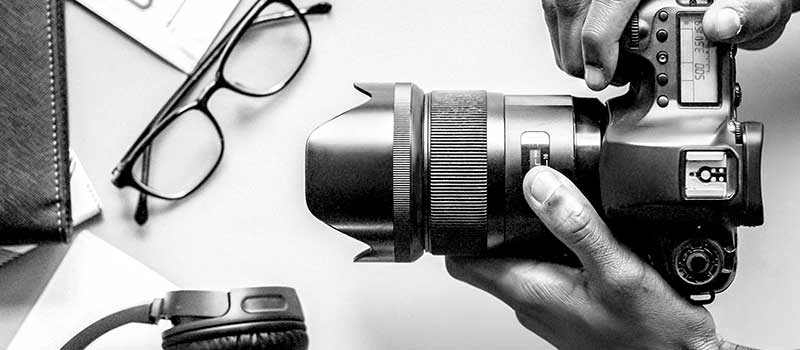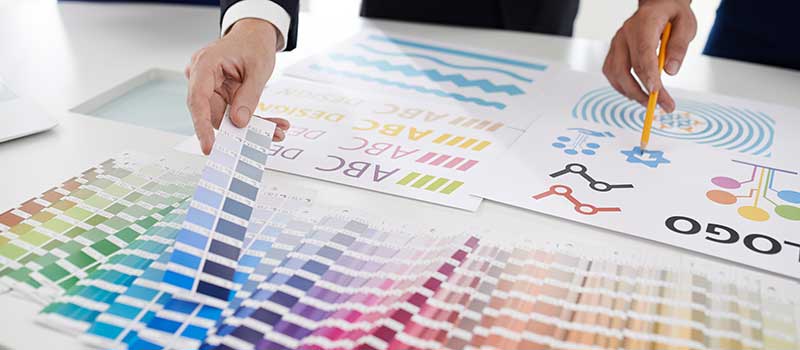An important part of building a brand strategy is planning and creating a strong visual identity.
Your visual identity is traditionally your logo, brand color, typography, and imagery.
You have a short space of time to make an impact on your audience, so creating a meaningful visual brand early on will ensure that you’re putting your best foot forward.
Ready to make an impact? Stay tuned as we check out some simple and inexpensive visual branding methods…
Brand Definition

When it comes to the branding process, many succumb to the excitement and prematurely dive headfirst into creating an attractive logo paired with slick, on-trend typography.
Whilst this is tempting to do, it’s far more important to define your brand strategy first.
This is because your brand is more than your visual elements.
it’s a story, a feeling and how you want your business to be perceived.
People buy from and use brands that align with their values, cares, and problems so, to resonate with your audience, you need to define your brand beyond the visual representations.
Start by asking yourself the following questions:
What are your brand values?
What is your brand’s mission?
What sets your business apart from the rest?
Why will your audience care about your offering?
How would you describe your company in three words?
Now in reality, these are surface level questions and to develop an effective strategy, you need to get a lot more granular but the more clarity you have on what your brand stands for, the more effective your visual identity will be, as you’ll be able to make well-informed design decisions that tell your brand story.
#1. Target Audience

Understanding your audience is key when it comes to creating a visual identity.
You likely already have an idea of who your demographic is, but fully establishing and researching your audience takes it one step further.
When you have a deeper understanding of who your potential customers are, you’ll be far more likely to build trust, credibility, and emotional connection with them. To do this, imagine you have the same persona as your audience and ask yourself the following questions:
What keywords would I naturally use to search for something?
What social media platforms and forums would I use?
What environmental, economic, or social causes do I care about?
What values do I look for in a business that I purchase from?
Search for similar products, startups, and businesses and look at the way that their audience is interacting with them and what sort of content is popular.
This research will help inform the way you name and market your brand, so it’s an important step.
PRO Brand Strategy BluePrint
Build Brands Like A Pro Brand Strategist

#2. Market Research

Searching for similar businesses and products is also a great opportunity to see what branding is currently out there. Your visual identity needs to set you apart from the crowd, differentiate you, and make your brand credible and unique.
Therefore, it’s crucial to establish exactly who the big players are in your market and how they represent themselves through visual language.
You want to establish common visual themes and evaluate how they relate to the values of your audience or the mission statement of the companies you are analysing. Investigate answers to the following questions:
What color themes are they using, and what emotions or values are they used to evoke or represent?
Does their logo use an image or an emblem, is it accompanied by text or standalone?
Do they use stock photography or images that they have taken themselves?
What typefaces are they using, in which size and in which context?
What is their tone of voice: is it serious or light-hearted?
If you notice a common or missing theme, it could be an opportunity to differentiate when creating your visual identity. Find out more on Competitive Positioning here.
Explore Brand Strategy
Programs & Tools
#3. Brand Personality

The personality of a brand goes a long way to influencing brand recognition and buying decisions of consumers.
Brand consistency across all channels contributes to the perception of the brand and a consistent brand experience builds trust.
From the first impression of the first touchpoint to the after purchase experience, a brand’s personality plays a critical role in how the brand is seen and how it connects.
Is your brand relatable, funny, rugged, tough, environmentally conscious or inspirational?
From Nike to Mcdonald’s, Apple to Coca-Cola, and beyond, successful brands understand their customers and make connections through attributes displayed in the personality of the brand.
#4. Tone Of Voice

The tone of voice that your brand uses isn’t necessarily a visual consideration, but it can influence your overall brand look.
For example, a professional, scientific TOV might not feel right with a youth-targeting brand, right?
Imagine you were comparing life insurance plans and found a small business penning the phrase ‘LOL’ whilst sharing memes on their social media, you would immediately discard this business in your mind as it’s unprofessional and unaligned to the product and customer values.
It’s an extreme and unlikely example, but it does highlight the importance of aligning business communications with customer values and your brand identity.
Target audience and competitor research should give you a foundation for establishing your tone of voice, so to build on this, consider the following regarding your brand:
Formal or informal – is your brand knowledgeable and authoritative, or personable and friendly?
Serious or humorous – does your brand have a sense of humour to share with its audience or need to be taken more seriously?
Enthusiastic or factual – is your brand friendly and helpful, or does it value being factual and literal over breeziness?
There’s some more in-depth guidance on Brand Voices here.
#5. Brand Design Elements

Now comes the part you’ve been waiting for – the actual visual design process.
This is where you take your defined core values, the target audience information, your market research and the TOV guidelines you’ve gathered to inform your name and visuals.
Brand Name & Logo

When you talk about brands and companies, the first thing that comes to your mind is their name and logo. It’s the most prevalent aspect of any strong brand, secondary only to their reputation.
They will be a potent branding asset that encapsulates your brand and is the face of your company – so choose wisely.
For the logo, decide whether you want to have an emblem, icon, or mascot, just the brand name. Or perhaps a logo design and color scheme that encapsulates these elements of your brand.
You also need to ensure that your new logo is scalable to varying sizes, easily identifiable, impactful, and unique (to stand out in the market), timeless, and (most importantly) relevant to your brand.
Typography And Fonts

Your font choices need to match your tone of voice.
If your company is serious and authoritative, light-hearted quirky fonts would be an immediate mismatch and harm the trustworthiness of your brand.
Instead, ensure your typography accurately matches your brand personality and manner of speech.
Pick a leading font (this will likely be in your logo if it contains text) and a complimentary, secondary font.
There are lots of great online tools that can assist when it comes to pairing fonts, or if you have in-house graphic designers, they will be a dab hand at making this decision with you.
Photography And Imagery

Imagery can be overlooked when it comes to brand identity, likely due to the wealth of fantastic stock websites out there.
Whilst there is nothing objectively wrong with using stock images, it can be difficult to find images that accurately represent your brand. Plus, there’s always the danger of crossover with the competition.
If you want to build trust with your audience, spend time finding either stock images that are niche and unique, or assign some of your marketing budget to work with a photographer and get some key shots.
Color Palette

Whether consciously or unconsciously, consumers associate colors with different feelings and emotions.
So, the primary colors for your brand should be chosen carefully to evoke the feelings and emotions you want from your audience.
For example, brands in the medical sector often use the color blue as it is associated with calmness, dependability, and trustworthiness, or that familiar grass green shade like the cross from worldwide pharmacies.
Furthermore, tech brands often choose bold colors like pink or orange to communicate drive, imagination, and vibrancy.
So think about how you want your brand to be perceived and which emotions should it evoke?
Then pick your color palette to match.
#6. Application

An important part of your visual identity is its physical representation and application.
So, it might be a good idea to put all your considerations and recommended usage into a Brand Guidelines document, that ways it’s all at hand for your marketing to begin.
When completing your guidelines, and including information on usage across all methods of communication, don’t forget to mention:
Website and social media platform
Advertisements and signage
Business cards and email signatures
Stationary such as letterheads, pens, pads, loyalty or brand stamps and compliment slips
Packaging and products
Storefronts
The aim is to bring the aspects of your brand together and apply them across all forms of communication for complete consistency.
If you have an existing business that you’re rebranding, it’s a good idea to conduct a full audit of your current methods of communication and try to enact all the changes at once.
Over To You
Your visual identity is much more than the actual look and should be informed by your values, customers, competitors and more.
So, spend the time, do your research and make sure your visuals are doing what they need to do.
On-Demand Digital Program
Brand Master Secrets
Make the transition from hired-gun to highly valued brand strategist in less than 30 days. The systems, frameworks and tools inside this comprehensive program are all you need to level up.








Lesson well explained coach.